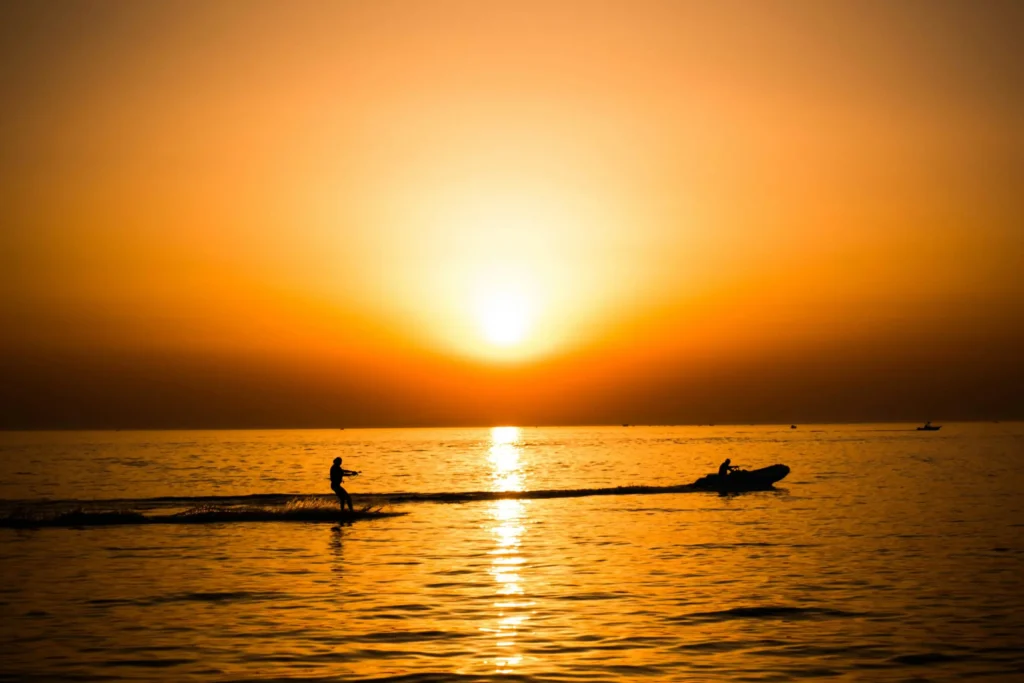Introduction:
Have you ever dreamed of gliding effortlessly across the water, propelled by the power of a speeding boat? Water skiing, a sport that combines the exhilaration of speed with the serenity of nature, offers an unforgettable experience for thrill-seekers and nature enthusiasts alike. In this comprehensive guide, we’ll delve into the world of water skiing, exploring its history, techniques, equipment, safety measures, and the best locations to enjoy this exhilarating sport.
Table of Contents

The Thrill of Water Skiing:
Water skiing is more than just a sport; it’s an escape from the ordinary, a chance to connect with the water and experience the thrill of speed. As you glide across the surface, the wind whipping through your hair and the sun warming your skin, you’ll feel a sense of freedom and exhilaration unlike anything else. Whether you’re a seasoned athlete or a curious beginner, water skiing offers a challenge that will test your balance, coordination, and endurance.
Adrenaline Rush on Water:
The moment you’re pulled from the water and begin to rise on your skis, an adrenaline rush surges through your veins. The boat accelerates, and you feel the exhilarating force propelling you forward. As you carve through the water, leaving a trail of spray behind you, you’ll experience a sense of pure joy and liberation. Water skiing is a sport that demands your full attention, requiring you to focus on maintaining your balance, controlling your speed, and navigating the waves. This intense focus allows you to escape the distractions of everyday life and immerse yourself in the present moment.
Combining Speed and Balance:
Water skiing is a delicate dance between speed and balance. As the boat pulls you forward, you must constantly adjust your weight distribution and body position to maintain control. The faster you go, the more challenging it becomes to stay upright. But with practice and perseverance, you’ll develop the skills necessary to navigate the water with grace and precision. The combination of speed and balance required in water skiing makes it a physically and mentally demanding sport, but the rewards are well worth the effort.

Unique Sensations of Gliding:
There’s nothing quite like the sensation of gliding effortlessly across the water on skis. The feeling of weightlessness, the gentle spray of water on your face, and the sound of the boat’s engine fading into the distance create a unique and unforgettable experience. As you carve through the water, you’ll feel a sense of connection with the natural world, becoming one with the waves and the wind. Water skiing offers a unique opportunity to escape the confines of land and experience the freedom of movement on the water.
Essential Equipment for Water Skiing:
To enjoy water skiing safely and effectively, you’ll need the following essential equipment:
Choosing the Right Skis:
Water skis come in various shapes and sizes, designed for different skill levels and riding styles. Beginners should opt for wider, shorter skis that offer greater stability and easier control. As you progress, you can move on to narrower, longer skis that allow for faster speeds and more advanced maneuvers.
Safety Gear: Life Jackets and Helmets:
Wearing a life jacket is mandatory for all water skiers, regardless of their skill level. Life jackets provide buoyancy and can save your life in case of an accident. Helmets are also highly recommended, especially for beginners, as they protect your head from potential injuries.
Tow Ropes and Handles:
The tow rope connects you to the boat and transmits the pulling force. Choose a rope that is the appropriate length for your height and skill level. The handle provides a comfortable grip and allows you to control the direction of the tow.
Boats and Engines:
Water skiing requires a boat with sufficient power to pull a skier at high speeds. The ideal boat size and engine power will depend on the number of skiers and the desired speed. Consult with a marine expert to determine the best boat and engine combination for your needs.
Mastering Basic Techniques:
Proper Starting Position:
Before starting, adjust the bindings on your skis to fit your feet snugly. Sit on the edge of the boat with your skis submerged in the water. Hold the tow rope handle with both hands, keeping your arms straight and your elbows slightly bent.
Getting Up on Skis:
Once the boat begins to accelerate, lean back slightly and extend your legs. As the rope pulls you forward, keep your knees bent and your body upright. Focus on maintaining your balance and avoid leaning too far forward or backward.
Maintaining Balance:
Once you’re up on skis, focus on keeping your weight evenly distributed and your body in an upright position. Use your arms to maintain balance and adjust your direction. Lean slightly into turns and keep your knees bent to absorb the impact of waves.
Turning and Maneuvering:
To turn, shift your weight slightly in the direction you want to go. Lean into the turn and use your arms to guide the skis. For sharper turns, use your body weight and the edge of your skis to carve through the water.
Stopping Safely:
To slow down, gradually reduce the boat’s speed. As you slow down, lean back slightly and extend your legs. Keep your knees bent and your body upright to maintain balance. Once the boat comes to a complete stop, slowly release the tow rope handle and step off your skis.
Advanced Water Skiing Tricks:
Once you’ve mastered the basics, you can start learning advanced water skiing tricks. These tricks require a high level of skill and balance, but they can add a whole new level of excitement to your water skiing experience. Some popular tricks include:
Crossing the Wake:
Crossing the wake involves skiing over the boat’s wake without losing your balance. This trick requires precise timing and coordination.
Jumping and Air Tricks:
Jumping involves launching yourself into the air using the wake as a ramp. Air tricks, such as flips and spins, can add an element of acrobatics to your water skiing.
Slalom Skiing:
Slalom skiing involves navigating a course of buoys while maintaining a constant speed. This trick requires precision and control.
Best Locations for Water Skiing:
Lakes and Reservoirs:
Lakes and reservoirs offer calm, flat water, making them ideal for beginners and those looking to practice their skills. The lack of waves and currents provides a stable environment for learning and improving.
Rivers with Calm Stretches:
Rivers with calm stretches can also be suitable for water skiing, especially for those with some experience. The flowing water adds a different dimension to the experience, requiring you to adjust your balance and technique accordingly.
Coastal Areas and Bays:
Coastal areas and bays offer a more challenging environment for water skiing due to the presence of waves and currents. However, they also provide stunning scenery and the opportunity to experience the thrill of riding waves.
Physical Benefits of Water Skiing:
Full-Body Workout:
Water skiing is an excellent full-body workout that engages multiple muscle groups. It strengthens your legs, core, arms, and shoulders, while also improving your cardiovascular endurance.
Improved Balance and Coordination:
Water skiing requires a high level of balance and coordination to maintain control on the water. This constant challenge helps to improve your overall balance and coordination, which can benefit other areas of your life.
Enhanced Cardiovascular Health:
Water skiing is an aerobic activity that gets your heart rate up and improves your cardiovascular health. It can help to lower your risk of heart disease, stroke, and other chronic conditions.
Water Skiing Safety Measures:
Understanding Weather Conditions:
Before heading out on the water, check the weather forecast and be aware of potential hazards such as storms, high winds, and lightning. Avoid skiing in rough water or during periods of low visibility.
Proper Communication with the Boat Driver:
Clear communication with the boat driver is essential for a safe and enjoyable water skiing experience. Establish hand signals or verbal commands to indicate your speed, direction, and any potential hazards.
Awareness of Surroundings:
Always be aware of your surroundings while water skiing.Keep an eye out for swimmers, other boats, and underwater impediments. Avoid skiing in areas with heavy boat traffic or near dams or other structures.
First Aid Knowledge:
It’s important to have basic first aid knowledge in case of an accident. Learn how to perform CPR and treat common injuries such as cuts, bruises, and sprains.
Conclusion:
Water skiing is a thrilling and rewarding sport that offers a unique combination of physical challenge, mental focus, and connection with nature. Whether you’re a seasoned athlete or a curious beginner, water skiing is an experience that will stay with you long after you’ve stepped off the skis. With proper preparation, safety measures, and a willingness to learn, you can unlock the world of water skiing and experience the exhilarating rush of gliding across the waves. So gather your friends, grab your skis, and get ready for an unforgettable adventure on the water!
